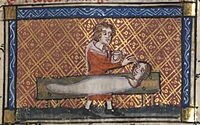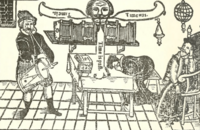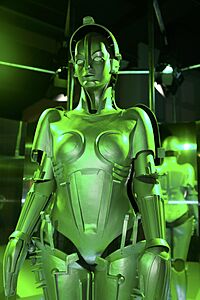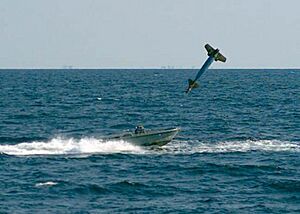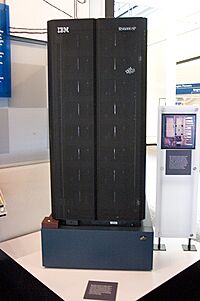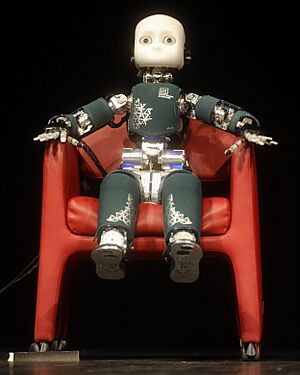History of robots facts for kids
The history of robots goes way back to ancient times. People have always dreamed of creating machines that could do things on their own. During the industrial revolution, humans learned how to use electricity to power machines with small motors. In the early 1900s, the idea of a machine that looked like a human, called a humanoid, started to become popular.
The first modern robots were used in factories. These industrial robots were fixed machines that could do manufacturing jobs. They helped make things with less human work. Since the 2000s, factories have used computer-controlled robots with artificial intelligence.
Contents
- Ancient Ideas: Legends and Myths
- Automata: Self-Moving Machines
- Modern Robot History
- The 1900s: Early Robot Ideas
- The 1910s: Chess-Playing Machines
- The 1920s: The Word "Robot" Appears
- The 1930s: Industrial Robots and Elektro
- The 1940s: Robotics and Cybernetics
- The 1950s: Unimate and Astro Boy
- The 1960s: Robots in Factories and Research
- The 1970s: Smart Weapons and Humanoid Robots
- The 1980s: New Robot Designs
- The 1990s: Robot Surgery and Space Exploration
- The 2000s: Robots Everywhere
- The 2010s: Robots in Daily Life
- See also
Ancient Ideas: Legends and Myths
Stories about artificial helpers and friends are very old. Some ancient legends tell of Cadmus, who planted dragon teeth that grew into soldiers. Another story is about Pygmalion, whose statue of Galatea came to life. Many old myths featured artificial people. For example, the Greek god Hephaestus (known as Vulcan to the Romans) built talking golden maidens.
A Buddhist scholar named Daoxuan (who lived from 596 to 667 AD) wrote about human-like machines made of metal. These machines recited sacred texts in a special building with a wonderful clock. They even cried when Buddha Shakyamuni passed away. Human-like machines also appear in the Epic of King Gesar, a famous story from Central Asia.
Old Chinese stories talk about the legendary carpenter Lu Ban and the philosopher Mozi. They described mechanical animals and demons. The idea of human-like machines was discussed in the Liezi, a collection of Daoist writings from the 4th century CE. In one story, King Mu of Zhou meets a craftsman named Master Yan Shi. The craftsman shows the king an artificial man that looks exactly like a real human. This machine performed many tricks for the king. But the king became angry when the machine seemed to flirt with the ladies. So, the craftsman opened the machine to show its inner workings. The king was amazed and experimented by removing different parts. He wondered if human skill could be as great as the Creator's. He then kept the machine. A similar story exists in ancient Indian Buddhist tales, but the machine there was not as complex.
The Indian Lokapannatti, a collection of stories from the 11th or 12th century AD, tells how an army of automated soldiers was made. These "Spirit movement machines" were built to protect Buddha's relics in a secret place. The plans for these human-like machines were supposedly stolen from the kingdom of Rome (a general term for Greek, Roman, and Byzantine cultures). The story says that the Greeks used these machines for trade, farming, and even to catch criminals. Roman machine makers who left the kingdom were hunted down by these automatons. The emperor Asoka hears about the secret place and finds it. After a battle with the fierce robot warriors, Asoka finds the engineer who built them. He learns how to take them apart and control them. This way, Emperor Asoka gains a large army of automated warriors. This Indian tale shows a fear of losing control over artificial beings, similar to Greek myths about the dragon-teeth army.
Inspired by European Christian legends, people in the Middle Ages imagined brazen heads that could answer questions. It was said that Albertus Magnus built a complete human-like robot that could do household chores. But his student Thomas Aquinas supposedly destroyed it because it disturbed his thoughts. The most famous legend is about a bronze head made by Roger Bacon. It was destroyed because he missed the exact moment it was supposed to work. Robots that looked like humans or animals were popular in medieval stories.
Automata: Self-Moving Machines
Around 300 BC, the mathematician Archytas of Tarentum imagined a mechanical bird he called "The Pigeon." It was powered by steam. Later, Aristotle thought that self-moving machines could someday end slavery. He wrote that if every tool could do its own work, like the statues of Daedalus or the tripods made by Hephaestus, then managers wouldn't need workers, and masters wouldn't need slaves.
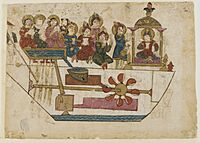
When the Greeks ruled Egypt, engineers in Alexandria built amazing self-moving machines. Ctesibius (285-222 BC) built human-like machines, often used in religious ceremonies. One of the last great Alexandrian engineers, Hero of Alexandria (10-70 CE), built a puppet theater where figures and sets moved mechanically. He described how to build such machines using pneumatics (air pressure). These engineers built automata to show human control over nature and as tools for priests. But they also started a trend of building automata for entertainment, especially for the wealthy.
The tradition of building automata continued in the Greek world into the Middle Ages. In 949, an ambassador named Liutprand of Cremona visited Constantinople. He described amazing machines in the emperor Theophilos' palace. There were golden lions that roared and moved their tails. There was also a gilded bronze tree with birds that sang like real ones. Even the emperor's throne could move up and down!
In China, the Cosmic Engine was a 10-meter (33-foot) clock tower built by Su Song in Kaifeng, China, in 1088 CE. It had mechanical mannequins that chimed the hours by ringing gongs or bells. Amazing automated devices continued to be built in the Tang dynasty. Daifeng Ma built an automated dresser for the queen. Ying Wenliang built a machine man that proposed toasts at banquets. He also made a wooden woman machine that played the sheng (a Chinese instrument). One of the best-known automata from ancient China was made by Han Zhile, a Japanese person who moved to China in the early 800s CE.
Societies after the classical era, like the Byzantines and Arabs, kept building automata. The Byzantines learned about automata from the Alexandrians. They improved them to build water clocks with gears. For example, Procopius described one around 510. But the biggest advancements in automata happened in the medieval Arab world. Harun al-Rashid built water clocks with complex hydraulic jacks and moving human figures. He even gifted one such clock to Charlemagne, King of the Franks, in 807. Arab engineers like Banu Musa and Al-Jazari wrote books about hydraulics. They further improved water clocks. Al-Jazari built automated moving peacocks powered by water. He invented water wheels with cams on their axles to operate automata.
One of al-Jazari's human-like machines was a waitress that could serve water, tea, or other drinks. The drink was stored in a tank and would drip into a cup after seven minutes. Then, the waitress would appear from an automatic door to serve the drink. Al-Jazari also invented a hand-washing automaton that used a flush system, similar to modern flush toilets. It had a female human-like machine standing by a basin of water. When a person pulled a lever, the water drained, and the machine refilled the basin. He also created a robotic musical band.
The segmental gears described in Al-Jazari's book, published just before his death in 1206, appeared in advanced European clocks 100 years later. Al-Jazari also gave instructions on how to build human-like machines. The first water clocks in Europe, based on Arabic designs, were built around 1000 CE. This knowledge likely came from contact between Muslims and Christians in Sicily and Spain. One of the first recorded European water clocks was built by Gerbert of Aurillac in 985 CE. Hero's writings on automata were translated into Latin during the 12th century Renaissance. In the early 1200s, the artist-engineer Villard de Honnecourt drew plans for several automata. By the late 1200s, Robert II, Count of Artois, built a pleasure garden with many robots, both human-like and animal-like. Automated bell-strikers, called jacquemart, became popular in Europe in the 1300s, along with mechanical clocks.
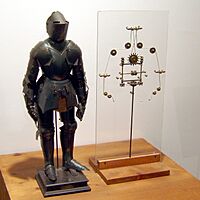
One of the first confirmed human-like machines was drawn by Leonardo da Vinci (1452–1519) around 1495. Leonardo's notebooks, found in the 1950s, contain detailed drawings of a mechanical knight in armor. This knight could sit up, wave its arms, and move its head and jaw. In the mid-1400s, Johannes Müller von Königsberg created an automaton eagle and fly made of iron, both of which could fly. John Dee is also known for making a wooden beetle that could fly.
The 17th-century thinker René Descartes believed that animals and humans were like biological machines. On his last trip to Norway, he brought a mechanical doll that looked like his deceased daughter, Francine. In the 1700s, the master toymaker Jacques de Vaucanson built an automated duck for Louis XV. It had hundreds of moving parts and could eat and drink. Vaucanson later built human-like machines, including a drummer and a fife player. These were known for how much they looked like real humans. Vaucanson's creations inspired European watchmakers to build mechanical automata. It became popular for rich Europeans to collect complex mechanical devices for fun. In 1747, Julien Offray de La Mettrie wrote a book called L'homme machine (Man a Machine). In it, he called Vaucanson a "new Prometheus" and suggested that "the human body is a watch, a large watch built with such skill and cleverness."
In the 1770s, the Swiss Pierre Jaquet-Droz created moving automata that looked like children. These delighted Mary Shelley, who later wrote the 1818 novel Frankenstein; or, The Modern Prometheus. The most famous attempt at an automaton was The Turk by Wolfgang von Kempelen. This machine seemed very smart and could play chess against a human. It toured Europe. When it came to the New World, Edgar Allan Poe wrote an essay about it. He concluded that mechanical devices could not truly reason or think. Later, The Mechanical Turk was revealed to be a clever trick: a human was hidden inside, operating it.
In the 1800s, the Japanese craftsman Hisashige Tanaka, known as "Japan's Edison," created many extremely complex mechanical toys. Some could serve tea, fire arrows, or even paint a Japanese kanji character. The important book Karakuri Zui (Illustrated Machinery) was published in 1796. In 1898, Nikola Tesla showed his "teleautomaton," a remote-controlled boat. He called it "an automaton which, left to itself, will act as though possessed of reason." He argued that it was not just a "wireless torpedo" but "the first of a race of robots, mechanical men which will do the laborious work of the human race."
Modern Robot History
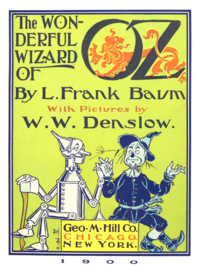
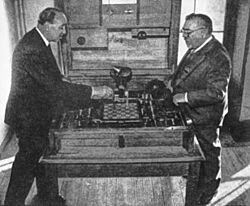
The 1900s: Early Robot Ideas
Starting in 1900, L. Frank Baum included modern technology in his Oz children's books. In The Wonderful Wizard of Oz (1900), Baum told the story of the cyborg Tin Woodman. He was a human woodcutter whose body parts were replaced with tin after his axe cut them off. In Ozma of Oz (1907), Baum described Tik-Tok, a copper clockwork man who needed to be wound up often.
In 1903, the Spanish engineer Leonardo Torres Quevedo introduced a radio-controlled system called the "Telekino." It was designed to test his airship without risking human lives. Unlike earlier on/off controls, Torres's system could control any mechanical or electrical device with different actions. The Telekino transmitter could send up to 19 different commands. In 1906, Torres showed his invention in the Port of Bilbao. He guided a boat with people on board from the shore, controlling it from over 2 kilometers (1.2 miles) away.
The 1910s: Chess-Playing Machines
In 1912, Leonardo Torres Quevedo built the first truly autonomous machine that could play chess. Unlike earlier chess-playing machines that had a human hidden inside, El Ajedrecista (The Chessplayer) was a real machine. It played a simple endgame with three chess pieces. It automatically moved a white king and a rook to checkmate the black king, which was moved by a human. In 1951, El Ajedrecista defeated Savielly Tartakower, becoming the first Grandmaster to be beaten by a machine. In his 1914 paper, Torres suggested a machine that could make "judgments." It would use sensors to gather information, parts like arms to interact with the world, and power sources. Most importantly, it would use current and past information to control its actions and adapt to changes around it.
The 1920s: The Word "Robot" Appears
The word "robot" was first used in a play by the Czech writer Karel Čapek in 1920. His play, R.U.R. (Rossum's Universal Robots), was a satire. In it, robots were manufactured biological beings that did all the unpleasant manual labor. Čapek said his brother Josef created the word from the Czech word robota, meaning 'forced labor' or 'work'. The play R.U.R. made the word "robot" more popular than "automaton."
Westinghouse Electric Corporation built Televox in 1926. It was a cardboard cutout connected to devices that users could turn on and off. In 1927, Fritz Lang's film Metropolis was released. The Maschinenmensch ("machine-human"), a female human-like robot (played by Brigitte Helm), was the first robot shown in a movie.
The most famous Japanese robot of this time was the Gakutensoku, shown in 1927. It was meant to have a diplomatic role. Powered by compressed air, it could write smoothly and raise its eyelids. Many robots were built before computers controlled them. They were mainly for public relations, like the automata of the 1700s. In 1928, one of the first human-like robots was shown in London. Invented by W. H. Richards, the robot, named Eric, had an aluminium suit of armor. It had eleven electromagnets and one motor powered by a 12-volt source. Eric could move its hands and head and be controlled by remote control or voice.
The 1930s: Industrial Robots and Elektro
The first designs for industrial robots were put into production in the United States. These "manipulators" had joints like human shoulders, arms, and wrists. They could copy human movements like pulling, pushing, and lifting. Their movements could be controlled by cam and switch programming. In 1938, Willard V. Pollard filed the first patent for such an arm. It had electronic controllers, pneumatic cylinders, and motors that powered six ways of motion. But its large drum memory made programming difficult and slow.
In 1939, the human-like robot known as Elektro appeared at the World's Fair. It was seven feet tall (2.1 m) and weighed 265 pounds (120 kg). Elektro could walk by voice command, speak about 700 words (using a record player), smoke cigarettes, blow up balloons, and move its head and arms. Its body was a steel gear cam and motor skeleton covered by an aluminum skin.
In 1939, Konrad Zuse built the first programmable electromechanical computer. This laid the groundwork for building human-like machines that are now called robots.
The 1940s: Robotics and Cybernetics
In 1941 and 1942, Isaac Asimov created the Three Laws of Robotics. In doing so, he also invented the word "robotics." In 1945, Vannevar Bush wrote an essay called As We May Think. It explored the potential of electronic data processing. He predicted the rise of computers, digital word processors, voice recognition, and machine translation.

In 1943, Arturo Rosenblueth, Norbert Wiener, and Julian Bigelow used the human central nervous system as a model for automatic weapons systems. They started the field of cybernetics (Greek for 'steersman'). They thought about how an animal's senses constantly send information to its brain, allowing it to control things like breathing and blood flow. After World War II, at a 1946 conference on cybernetics, Warren McCulloch brought together experts to work on machines using biological systems as a starting point. Wiener's idea that non-living systems could act like biological ones using sensors led to cybernetic ideas being used in industrial machines.
The first electronic robots that could act on their own with complex behaviors were made by William Grey Walter in England in 1948 and 1949. He wanted to show that even a few brain cells connected in rich ways could lead to very complex behaviors. His first robots, named Elmer and Elsie, were built between 1948 and 1949. They were often called "tortoises" because of their shape and slow movement. These three-wheeled tortoise robots could find their way to a recharging station when their batteries were low.
Walter believed in using analogue electronics to copy brain processes. This was at a time when others, like Alan Turing and John von Neumann, were focusing on digital computation. Walter's work inspired later robot researchers. Modern versions of Walter's "turtles" can be found in BEAM robotics.
The 1950s: Unimate and Astro Boy
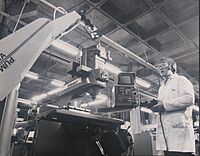
In 1951, Walter published a paper called A Machine that learns. It showed how his more advanced mechanical robots could learn through conditioned reflexes, acting like intelligent agents.
Unimate, the first robot that could be controlled digitally and programmed, was invented by George Devol in 1954. It is considered the start of the modern robotics industry.
In Japan, robots became popular characters in comic books. Robots became cultural icons, and the Japanese government started funding research into robotics. One of the most famous characters was Astro Boy, who learned human feelings like love and courage. In Japanese culture, robots were seen as helpful partners to humans.
The use of transistors in computers in the mid-1950s made them smaller and more powerful. This meant that computing and programming could be used in many areas, including automation. In 1959, researchers at the Massachusetts Institute of Technology (MIT) showed how computers could help with manufacturing.
The 1960s: Robots in Factories and Research
Devol sold the first Unimate to General Motors in 1960. It was installed in 1961 in a factory in Ewing Township, New Jersey. Its job was to lift hot metal pieces from a die casting machine and put them into cooling liquid. This was the world's first working robot on an assembly line. Devol's patent for this programmable robotic arm is the basis of the modern robotics industry.
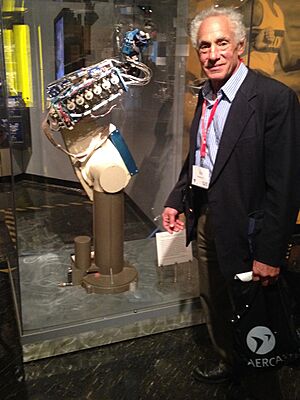
The Rancho Arm was created to help patients with disabilities at the Rancho Los Amigos Hospital in Downey, California. Stanford University bought this computer-controlled arm in 1963. In 1967, the first industrial robot was used in Japan. It was the Versatran robot, developed by American Machine and Foundry. A year later, a hydraulic robot designed by Unimation was put into production by Kawasaki Heavy Industries. Marvin Minsky created the Tentacle Arm in 1968. This arm was computer-controlled, and its 12 joints were powered by hydraulics. In 1969, engineering student Victor Scheinman created the Stanford Arm. It is known as the first electronic computer-controlled robotic arm.
In the late 1960s, the Vietnam War became a testing ground for automated control technology and sensor networks. In 1966, the idea of the McNamara Line was proposed. It was a network of sensors and land mines meant to reduce the need for ground forces. It was only partly built because it was too expensive. The first mobile robot that could understand its surroundings, Shakey, was built in 1970 by the Stanford Research Institute. Shakey used multiple sensors, including TV cameras, laser rangefinders, and "bump sensors," to move around.
The 1970s: Smart Weapons and Humanoid Robots
In the early 1970s, smart weapons were developed. Weapons became robotic by using terminal guidance. At the end of the Vietnam War, the first laser-guided bombs were used. These bombs could find their target by following a laser beam pointed at it. During the 1972 Operation Linebacker, laser-guided bombs were effective, but they still needed a lot of human control. "Fire-and-forget" weapons were also first used in the Vietnam War. Once launched, these weapons did not need any more attention from the operator.
Japanese robotics scientists made big advancements in human-like robots in the 1970s. Waseda University started the WABOT project in 1967. In 1972, they finished the WABOT-1, the world's first full-size intelligent human-like robot. It could walk, grip objects with its hands using touch sensors, and measure distances with its artificial eyes and ears. It could also talk to people in Japanese using an artificial mouth. This made it the first android.
Freddy and Freddy II were robots built at the University of Edinburgh School of Informatics. They could assemble wooden blocks over several hours. The German company KUKA built the world's first industrial robot with six electrically powered axes, called FAMULUS.
In 1974, Michael J. Freeman created Leachim, a robot teacher. Leachim was programmed with the class curriculum and information about 40 students. Leachim could also speak. It was tested in a fourth-grade classroom in New York City.
In 1974, David Silver designed The Silver Arm. It could make very precise movements like human hands. It used touch and pressure sensors for feedback, which a computer analyzed. The SCARA, or Selective Compliance Assembly Robot Arm, was created in 1978. It was an efficient, 4-axis robotic arm. It was best for picking up parts and placing them elsewhere. The SCARA was introduced to assembly lines in 1981.
The Stanford Cart successfully crossed a room full of chairs in 1979. It mainly used stereo vision to navigate and figure out distances. The Robotics Institute at Carnegie Mellon University was founded in 1979 by Raj Reddy.
The 1980s: New Robot Designs
Takeo Kanade created the first "direct-drive arm" in 1981. Its motors were inside the robot itself, which made it simpler.
In 1984, Wabot-2 was shown. It could play the organ, had 10 fingers and two feet. Wabot-2 could read music and play along with a person.
In 1986, Honda started its research to create human-like robots that could interact well with people. A six-legged robot named Genghis was revealed by MIT in 1989. Genghis was known for being built quickly and cheaply. It used 4 microprocessors, 22 sensors, and 12 servo motors. Rodney Brooks and Anita M. Flynn wrote a paper suggesting smaller, cheaper robots. They thought this would speed up production and make it easier to launch robots into space.
The 1990s: Robot Surgery and Space Exploration
In 1994, one of the most successful robot-assisted surgery devices was approved. The Cyberknife was invented by John R. Adler. The first system was installed at Stanford University in 1991. This system combined image-guided surgery with robotic positioning. The Cyberknife is now used to treat patients with brain or spine tumors. An x-ray camera tracks movement and adjusts for breathing.
The biomimetic robot RoboTuna was built in 1996 to study how fish swim. RoboTuna is designed to swim and look like a bluefin tuna.
Honda's P2 human-like robot was first shown in 1996. P2 was an important part of Honda's robot project. It was over 6 feet (1.8 m) tall, smaller than earlier models, and moved more like a human.
The Sojourner rover was expected to work for only seven days but kept going for 83 days in 1997. This small robot (only 23 lbs or 10.5 kg) performed tasks on the surface of Mars. It was part of the Mars Pathfinder mission. Sojourner had an obstacle avoidance program and could plan routes to study the planet's surface. Its ability to navigate with little information about its surroundings helped it react to unexpected events.
The P3 human-like robot was revealed by Honda in 1998. In 1999, Sony introduced the AIBO, a robotic dog that could interact with humans. The first models sold out in Japan in 20 minutes. Honda showed the most advanced result of their human-like robot project in 2000, named ASIMO. ASIMO can run, walk, talk to humans, recognize faces, environments, voices, and postures. It can also interact with its surroundings. Sony also revealed its Sony Dream Robots, small human-like robots for entertainment. In October 2000, the United Nations estimated there were 742,500 industrial robots worldwide. More than half of them were used in Japan.
The 2000s: Robots Everywhere
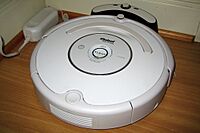
In April 2001, the Canadarm2 was launched into space and attached to the International Space Station. The Canadarm2 is a larger, more capable version of the arm used by the Space Shuttle. Also in April, the Unmanned Aerial Vehicle Global Hawk made the first autonomous non-stop flight over the Pacific Ocean. It flew from California to Southern Australia in 22 hours.
The popular Roomba, a robotic vacuum cleaner, was first released in 2002 by the company iRobot.
In 2005, Cornell University showed a robotic system made of block-modules that could attach and detach. It was described as the first robot capable of self-replication. It could build copies of itself if placed near more of its blocks. Launched in 2003, the Mars rovers Spirit and Opportunity landed on Mars. Both robots traveled much farther than expected. Opportunity was still working in mid-2018 before a dust storm caused it to lose communication.
Self-driving cars started appearing around 2005, but they needed improvement. None of the 15 robots in the DARPA Grand Challenge (2004) finished the course. In fact, no robot completed more than 5% of the 150-mile (240 km) off-road course. In 2005, Honda showed a new version of its ASIMO robot with new abilities. In 2006, Cornell University revealed its "Starfish" robot, a four-legged robot that could learn to walk after being damaged. In 2007, TOMY launched the i-sobot, a human-like robot that could walk, kick, punch, and do tricks.
The 2010s: Robots in Daily Life
The 2010s saw big improvements in robotic parts. Robots became more common in everyday life. This led to both excitement and new worries.
Human-like robots continued to get better. Robonaut 2 was launched to the International Space Station in 2011. It was the first humanoid robot in space. Its first goal was to teach engineers how skilled robots act in space. The hope is that with upgrades, it could one day help spacewalkers make repairs or do scientific work outside the station. By the end of the decade, human-like and animal-like robots could clear difficult obstacle courses, keep their balance, and even do gymnastics. However, most robot developments in the 2010s involved smaller, more specialized robots that were cheaper and more capable.
Moore's Law and better integration of digital electronic parts made it possible for robots to do complex calculations with smaller devices. Many of these advances came from the growth of smartphones.
The cost and weight of these parts dropped, leading to many new types of robots. Quadcopters, which were new at the start of the decade, became very common. They could navigate and stabilize themselves and carry powerful sensors, including high-definition cameras. By the end of the decade, a robotic quadcopter with 4K cameras and self-navigation was affordable for hobbyists. Companies like Amazon explored using quadcopters for delivery.
The decade also saw a boom in artificial intelligence. Robots' onboard computers became powerful enough to do complex actions without human guidance. They could also process data in more complex ways. The growth of mobile data networks and powerful graphics cards for AI also allowed robots to communicate with distant computer systems in real time. This boosted the abilities of even simple robots.
New software ideas also grew in the 2010s. Neural networks became much better. Companies like Google offered free access to tools like TensorFlow. This allowed robot makers to quickly add neural networks for things like facial recognition and object identification, even in small, cheap robots.
The growth of robots in the 2010s also happened with the rise of open source software. Many companies offered free access to their AI software. Open source hardware, like the Raspberry Pi (small computers) and Arduino (small microcontrollers), became more powerful and cheaper. Along with cheaper manufacturing methods like 3D printing, these parts allowed hobbyists, researchers, and manufacturers to quickly build special robots with high levels of artificial intelligence. They could also share their designs worldwide.
Self-driving cars moved from being just an idea to becoming a reality during the decade. By the end of the 2010s, most new cars had robotic systems that could warn drivers about dangers like nearby vehicles or drifting out of a lane. In 2014, new Tesla cars were fitted with hardware to support a full autopilot system. More autonomous software updates arrived in later years. By the end of the decade, self-driving was possible on large highways, but still needed human supervision.
The growth of robot abilities also led to worries. Large tech companies gained a lot of power. People worried that the abilities of these robots could be misused. For example, when Amazon bought Roomba, privacy advocates worried that data about users' homes collected by the robots' sensors and cameras could be stored and shared without permission. Also, the common use of small flying quadcopters, home automation, and facial recognition by robots raised concerns about human rights and privacy. As robots could do more tasks once done only by humans, many experts worried that robots controlling complex systems might not have the moral or ethical safeguards needed for public safety.
Throughout the 2010s, humans continued to think about their relationship with robots. Many people believed that robots were or would become conscious beings deserving of rights. They saw robots as potential allies or rivals. On October 25, 2017, a robot named Sophia was granted Saudi Arabian citizenship. This made her the first robot to have a nationality. This caused debate, as it was unclear if Sophia could vote or marry, or if turning her off could be considered murder. It was also controversial because Saudi human women have limited rights. Popular artworks in the 2010s, like HBO's Westworld, encouraged empathy for robots and explored questions of humanity and consciousness.
By the end of the decade, commercial and industrial robots were widely used. They did jobs more cheaply or accurately than humans. They were used in manufacturing, assembly, packing, transport, space exploration, surgery, and research. The growing use of robots in many jobs, including those that used to require human skills, led to fears of widespread technological unemployment.
By the very end of the decade, robotics started making progress at the tiny nanotechnology scale. In 2019, engineers created millions of nanobots using technology from the semiconductor industry. These microscopic robots, small enough to be injected into the human body and controlled wirelessly, could one day deliver medicines and perform surgeries. This could change medicine and health.
See also


